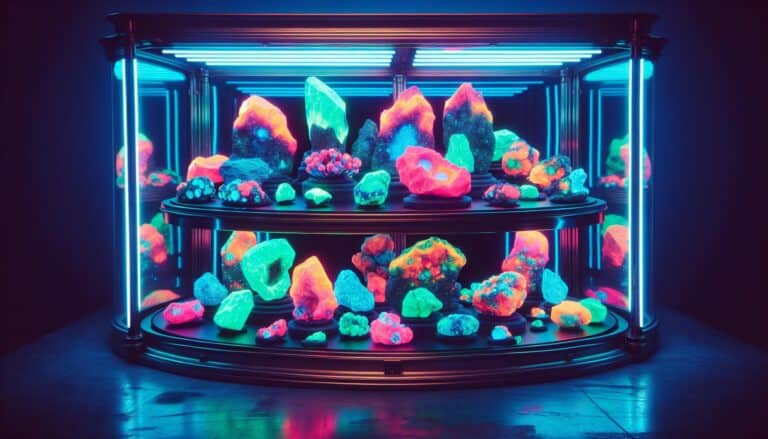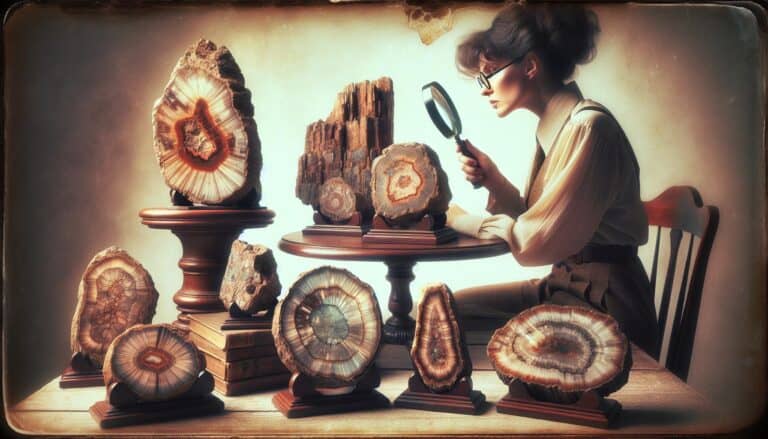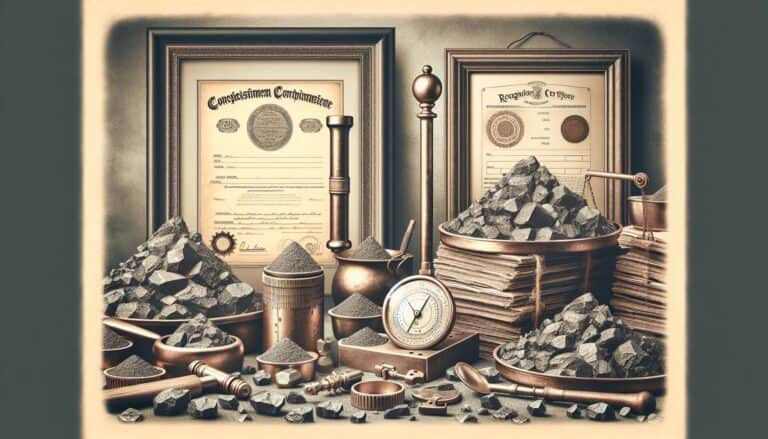Identifying quartz might seem daunting, but with a few simple tips, you’ll be spotting this common mineral like a pro.
It’s all about knowing what to look for, from its distinct features to the subtle nuances that set it apart from imposters.
To identify quartz, check for a glassy luster and color range from clear to pink (rose quartz) or violet (amethyst). Quartz leaves a white streak, is not magnetic, has a Mohs hardness of 7, scratches glass, and is singly refractive with a specific gravity of 2.6-2.7.
How to Identify Quartz Through Testing
Visual Inspection
Kickstart your quartz identification by simply looking at your specimen. Quartz has a glassy luster and can be transparent to translucent. Notice the color variations – they may range from colorless to shades of pink, or even violet if it’s amethyst, a popular variety. Keep an eye out for crystal faces and edges that are typically sharp and angular with distinctive hexagonal form.
The Streak Test
You can drag your suspected quartz across an unglazed ceramic plate. Quartz will leave a white or colorless streak, while other minerals may leave different colored streaks. This test can help rule out imposters with simple streaks.
Magnet Test
Although quartz isn’t magnetic, this quick test can distinguish it from other minerals like magnetite. Pass a strong magnet over the stone – the absence of magnetic attraction will support your hunch that it’s quartz.
Hardness Test
Quartz ranks at a seven on the Mohs hardness scale. Measure its hardness by seeing if it can scratch common items:
- Glass (Hardness of 5.5)
- Steel File (Hardness of 6.5)
If quartz scratches these items but not a piece of corundum, which is a 9 on Mohs scale, you’ve likely got quartz.
Birefringence Test
Look for the optical phenomenon of birefringence by placing your sample between crossed polarizing filters. Quartz’s crystalline structure may produce a visible light pattern indicative of its birefringent nature.
Checking The Diaphaneity
Diaphaneity describes how light passes through a mineral. Quartz ranges from transparent to translucent, meaning light can move through it, but the mineral may not be perfectly clear.
Single or Double Refraction
While performing visual inspection, notice whether your stone splits light into a double image. Quartz is typically singly refractive, meaning it should not create a double image.
Refractive Index Test
Professional tools are used for this test. Quartz has a known refractive index ranging from 1.544 to 1.553. If your gemstone tester shows these values, you’re on the right track.
Finding The Specific Gravity
Quartz has a specific gravity between 2.6 to 2.7. Compare it to known weights to gauge if your specimen falls within this range.
Identifying Quartz in the Field
When scouting for quartz in natural settings, look for veins within rock formations; they often harbour quartz deposits. Check for the hard, glassy material typically associated with quartz.
Recognizing Potential Quartz Rocks
Quartz is often found embedded within other rocks. Keep your eye out for rocks that possess clear, glassy crystals, or even ones with a waxy luster that could be a sign of chalcedony, a form of quartz.
Physical Characteristics of Quartz

Quartz is one of the most abundant and varied minerals on Earth, it’s recognizable by several key physical attributes. You’ll find quartz in colors that range from clear to pink, to brown, and even black. Color variations can signal the presence of different types of quartz; for instance, amethyst is a purple variety while citrine is known for its yellow hues.
The physical form of quartz is equally distinct. It typically crystallizes into hexagonal prisms with pyramid-like ends, which can either be singular or clustered formations. One of the telltale signs you’re dealing with quartz is its glassy luster, which gives it that characteristic shine and indicates a high degree of transparency or translucency.
Another powerful indicator of quartz is its hardness. Measuring a 7 on the Mohs scale, it’s significantly harder than many common materials. You can perform a simple hardness test by trying to scratch a piece of glass or a kitchen knife with your suspected quartz; if it leaves a mark, it’s likely you’re holding quartz.
Lastly, take note of the crystal’s cleavage and fracture patterns. Quartz doesn’t have natural cleavage, which means it won’t split along well-defined planes like mica or calcite. Instead, it fractures in a conchoidal manner, creating smooth, curved surfaces on broken pieces. This distinctive breakage pattern is a good clue in identifying quartz in the field.
By familiarizing yourself with these characteristics, you’ll enhance your ability to recognize quartz on sight, paving the way for more advanced identification methods.
How Are Quartz Formed?
Understanding the formation of quartz is key to recognizing it in natural settings. Quartz forms when silica-rich solutions, often released from magma, cool down and crystallize. The process can take thousands to millions of years, which is part of why quartz is so common in the Earth’s crust.
- Hydrothermal Process: Many quartz crystals form from hydrothermal vents where hot, mineral-rich water cools down.
- Pegmatites: These are extremely coarse-grained igneous rock where large quartz crystals can be found.
- Metamorphism: The transformation of existing rocks under heat and pressure can also result in quartz formation.
When identifying quartz, it’s essential to consider these origins. Pegmatitic quartz, for instance, often has a distinct crystal shape due to slower cooling times, while metamorphic quartz may be more intertwined with other minerals, showing signs of transformation. By looking at a rock’s structure and considering the environment it’s found in, you’ll get clues about the presence of quartz.
As you continue to explore different areas, keep in mind that quartz can be found worldwide. Its abundance makes it a common find but doesn’t diminish its role in geological history or its importance to collectors and enthusiasts alike. Remember, your knowledge of quartz formation complements the visual and test methods previously outlined, giving you a comprehensive understanding of this versatile mineral.
Preparation for Quartz Hunting
Gathering the Right Tools
To maximize your success and efficiency in quartz hunting, you’ll need to arm yourself with the right tools. Essential items for your toolkit should include:
- A sturdy hammer or geological pick for extracting crystals
- Chisels of various sizes for precise work
- Safety goggles to protect your eyes from flying debris
- Durable gloves to shield your hands
- A magnifying glass or jeweler’s loupe to closely inspect specimens
- A scratch tile for the streak test, allowing you to determine the mineral content
- Plastic bags or containers for transporting your finds
Packing these tools ensures you’re prepared to identify and collect quartz specimens with care and precision.
Safety Considerations
When you’re out in the field, your safety should be your top priority. Here’s what you need to remember:
- Wear proper attire, including long pants and a sturdy pair of boots to protect against sharp rocks and uneven terrain.
- Always use safety equipment, such as goggles and gloves, when breaking rocks to prevent injuries.
- Stay hydrated and bring sufficient water, especially if you’re hunting in a remote area or during hot weather.
- Inform someone of your location and expected return time, in case you encounter an emergency.
- Be mindful of wildlife and terrain hazards which can present unexpected risks.
- Have a first aid kit on hand for minor injuries and know the basics of first aid treatment.
Equipped with the correct tools and a mind attuned to safety, you’ll be well on your way to discovering the hidden wonders of quartz.
Handling and Care of Found Quartz

Once you’ve successfully identified and collected quartz, proper handling and care are crucial to maintain its natural beauty. Your newfound treasures, like any gemstones, require gentle care to ensure they remain in pristine condition for years to come.
Cleaning and Storing Quartz
After a successful quartz hunting trip, you’ll want to clean your finds to reveal their true luster. Here’s how to clean and store them safely:
- Rinse with Water: Begin by carefully rinsing your quartz in lukewarn water to remove loose dirt and debris. Avoid high water pressure which can cause damage.
- Gentle Brushing: Use a soft brush, such as a toothbrush, to gently scrub the surfaces. Toothpaste should be avoided, as it can be abrasive.
- Soaking: For stubborn stains, soak the quartz in water with a bit of mild dish soap. After soaking, scrub gently again.
- Drying: Pat the quartz dry with a soft towel. Allow it to air dry completely before storing.
When it comes to storage, it’s imperative to keep your quartz safe from scratches and damage:
- Separate Compartments: Store each quartz piece in a separate compartment or a soft pouch to prevent them from scratching each other.
- Avoid Direct Sunlight: Long-term exposure to direct sunlight can fade some quartz varieties. Keep them in a cool, dark place.
- Stable Temperature: Extreme temperature variations can cause cracking. Store your quartz in an environment with a stable temperature.
- Moisture-Free: Ensure the storage area is dry to prevent potential damage from moisture.
By following these cleaning and storing guidelines, you’ll help protect and sustain the inherent beauty of your quartz pieces. Your care will enable you to appreciate their unique qualities to the fullest without compromising their integrity.
Conclusion: Confirming Real Quartz
You’re now equipped with the knowledge to distinguish quartz from other minerals.
Remember, the right tools and a keen eye are your best allies in this quest. Whether you’re out in the field or examining a potential find at home, your new understanding of quartz identification will serve you well. Take pride in your ability to recognize and care for these natural treasures. With each piece you correctly identify, you’ll not only enrich your collection but also deepen your connection to the earth’s geological wonders.
Embrace the adventure of quartz hunting; who knows what you’ll discover next!



![Colorado Rockhounding Sites in [year]: Locations & Treasures](https://observationhobbies.com/wp-content/uploads/2024/01/Q3VYeHzjigdPh5fyG3DP_-768x439.jpg)


![Minnesota Rockhounding Sites in [year]: Sites & Treasures](https://observationhobbies.com/wp-content/uploads/2024/01/xm-C_w7-bWk5JVfXXKpun-768x439.jpg)
